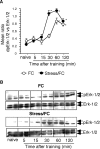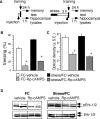Mitogen-activated protein kinase signaling in the hippocampus and its modulation by corticotropin-releasing factor receptor 2: a possible link between stress and fear memory
- PMID: 14673008
- PMCID: PMC6740521
- DOI: 10.1523/JNEUROSCI.23-36-11436.2003
Mitogen-activated protein kinase signaling in the hippocampus and its modulation by corticotropin-releasing factor receptor 2: a possible link between stress and fear memory
Abstract
A coordinated activation of multiple interlinked signaling pathways involving cAMP-dependent protein kinase (PKA) and mitogen-activated extracellular signal-regulated kinases (Mek-1/2) regulates gene expression and neuronal changes underlying memory consolidation. In the present study we investigated whether these molecular cascades might mediate the effects of stress on memory formation. We also investigated the role of hippocampal corticotropin-releasing factor receptor 2 (CRF2) in stress-enhanced learning and molecular signaling mediated by PKA, Mek-1/2, and their downstream targets extracellularly regulated kinases 1 and 2 (Erk-1/2) and p90-ribosomal-s-kinase-1 (p90Rsk-1). Acute 1 hr immobilization was used as a stressful stimulus, and one-trial context-dependent fear conditioning was used as a model for associative learning. Training of BALB/c mice 3 hr after the end of immobilization resulted in an enhancement of conditioned fear, as indicated by significantly increased freezing behavior of stressed when compared with nonstressed mice. Interestingly, Erk-1/2 phosphorylation after conditioning of nonstressed and stressed mice depended on PKA and Mek-1/2, respectively. Intrahippocampal injection of the selective Mek-1/2 inhibitor U0126 or CRF2 antagonist antisauvagine-30 (aSvg-30) prevented stress-enhanced fear conditioning and Mek-1/2-dependent activation of Erk-1/2 and p90Rsk-1. aSvg-30 did not affect the phosphorylation of the PKA regulatory subunit II of stressed mice. The molecular and behavioral effects of CRF2 coincided with stress-induced upregulation of CRF2 mRNA. These results suggest that modulation of Mek-1/2-dependent signaling by hippocampal CRF2 can be selectively involved in the delayed effects of stress on memory consolidation.
Figures







Similar articles
-
The role of hippocampal signaling cascades in consolidation of fear memory.Behav Brain Res. 2004 Feb 4;149(1):17-31. doi: 10.1016/s0166-4328(03)00207-9. Behav Brain Res. 2004. PMID: 14739006
-
Suppression of the MEK/ERK signaling pathway reverses depression-like behaviors of CRF2-deficient mice.Neuropsychopharmacology. 2009 May;34(6):1416-26. doi: 10.1038/npp.2008.178. Epub 2008 Oct 8. Neuropsychopharmacology. 2009. PMID: 18843268 Free PMC article.
-
Phosphorylation of hippocampal Erk-1/2, Elk-1, and p90-Rsk-1 during contextual fear conditioning: interactions between Erk-1/2 and Elk-1.Mol Cell Neurosci. 2002 Nov;21(3):463-76. doi: 10.1006/mcne.2002.1188. Mol Cell Neurosci. 2002. PMID: 12498787
-
The neuronal MAP kinase cascade: a biochemical signal integration system subserving synaptic plasticity and memory.J Neurochem. 2001 Jan;76(1):1-10. doi: 10.1046/j.1471-4159.2001.00054.x. J Neurochem. 2001. PMID: 11145972 Review.
-
The influence of stress on fear memory processes.Braz J Med Biol Res. 2012 Apr;45(4):308-13. doi: 10.1590/s0100-879x2012007500045. Epub 2012 Mar 29. Braz J Med Biol Res. 2012. PMID: 22450371 Free PMC article. Review.
Cited by
-
Sex and chronic stress alter delta opioid receptor distribution within rat hippocampal CA1 pyramidal cells following behavioral challenges.Neurobiol Stress. 2020 Jun 22;13:100236. doi: 10.1016/j.ynstr.2020.100236. eCollection 2020 Nov. Neurobiol Stress. 2020. PMID: 33344692 Free PMC article.
-
Hippocampal Mek/Erk signaling mediates extinction of contextual freezing behavior.Neurobiol Learn Mem. 2007 Jan;87(1):149-58. doi: 10.1016/j.nlm.2006.08.003. Epub 2006 Sep 18. Neurobiol Learn Mem. 2007. PMID: 16979915 Free PMC article.
-
Corticotropin-releasing hormone activates ERK1/2 MAPK in specific brain areas.Proc Natl Acad Sci U S A. 2005 Apr 26;102(17):6183-8. doi: 10.1073/pnas.0502070102. Epub 2005 Apr 15. Proc Natl Acad Sci U S A. 2005. PMID: 15833812 Free PMC article.
-
Neurocognitive effects of stress: a metaparadigm perspective.Mol Psychiatry. 2023 Jul;28(7):2750-2763. doi: 10.1038/s41380-023-01986-4. Epub 2023 Feb 9. Mol Psychiatry. 2023. PMID: 36759545 Free PMC article. Review.
-
Hippocampal Erk mechanisms linking prediction error to fear extinction: roles of shock expectancy and contextual aversive valence.Learn Mem. 2009 Mar 24;16(4):273-8. doi: 10.1101/lm.1240109. Print 2009 Apr. Learn Mem. 2009. PMID: 19318469 Free PMC article.
References
-
- Abel T, Nguyen PV, Barad M, Deuel TA, Kandel ER, Bourtchouladze R ( 1997) Genetic demonstration of a role for PKA in the late phase of LTP and in hippocampus-based long-term memory. Cell 88: 615-626. - PubMed
-
- Athos J, Impey S, Pineda VV, Chen X, Storm DR ( 2002) Hippocampal CRE-mediated gene expression is required for contextual memory formation. Nat Neurosci 5: 1119-1120. - PubMed
-
- Atkins CM, Selcher JC, Petraitis JJ, Trzaskos JM, Sweatt JD ( 1998) The MAPK cascade is required for mammalian associative learning. Nat Neurosci 1: 602-609. - PubMed
-
- Bapat S, Verkleij A, Post JA ( 2001) Peroxynitrite activates mitogen-activated protein kinase (MAPK) via a MEK-independent pathway: a role for protein kinase C. FEBS Lett 499: 21-26. - PubMed
-
- Behan DP, Heinrichs SC, Troncoso JC, Liu XJ, Kawas CH, Ling N, De Souza EB ( 1995) Displacement of corticotropin releasing factor from its binding protein as a possible treatment for Alzheimer's disease. Nature 378: 284-287. - PubMed
Publication types
MeSH terms
Substances
LinkOut - more resources
Full Text Sources
Medical
Molecular Biology Databases
Miscellaneous
